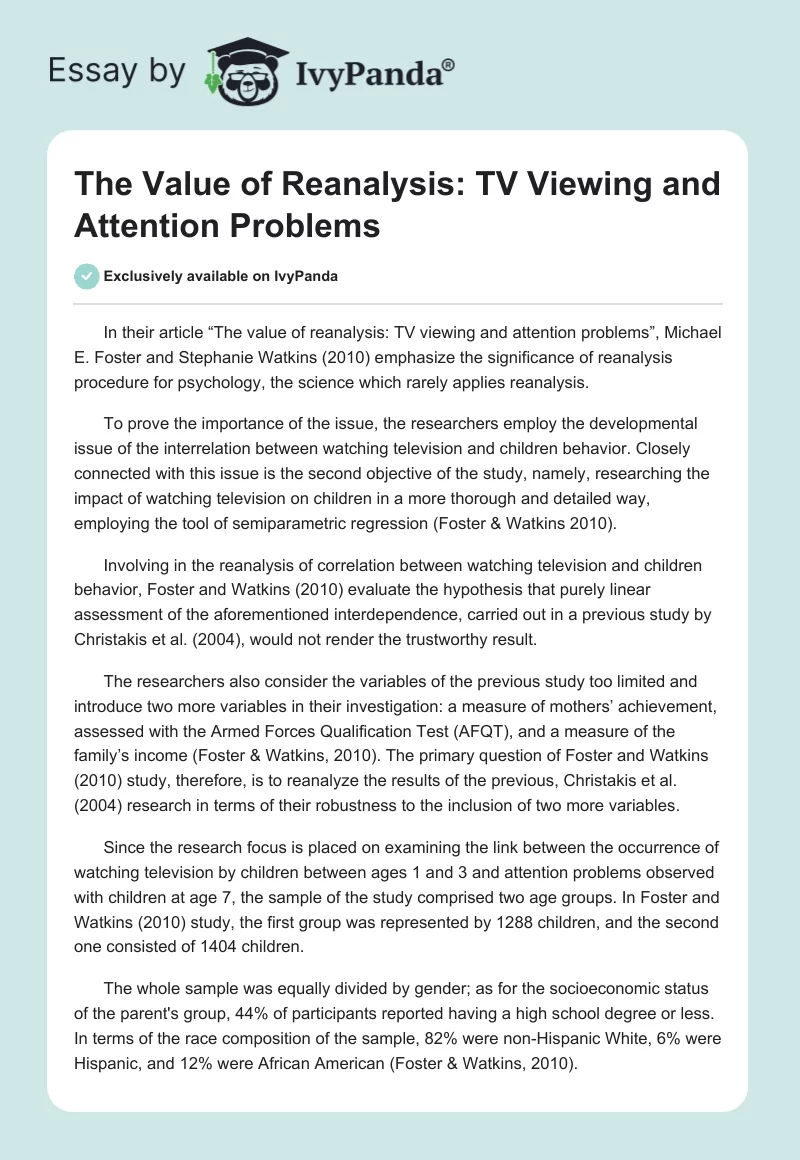In their article “The value of reanalysis: TV viewing and attention problems”, Michael E. Foster and Stephanie Watkins (2010) emphasize the significance of reanalysis procedure for psychology, the science which rarely applies reanalysis.
To prove the importance of the issue, the researchers employ the developmental issue of the interrelation between watching television and children behavior. Closely connected with this issue is the second objective of the study, namely, researching the impact of watching television on children in a more thorough and detailed way, employing the tool of semiparametric regression (Foster & Watkins 2010).
Involving in the reanalysis of correlation between watching television and children behavior, Foster and Watkins (2010) evaluate the hypothesis that purely linear assessment of the aforementioned interdependence, carried out in a previous study by Christakis et al. (2004), would not render the trustworthy result.
The researchers also consider the variables of the previous study too limited and introduce two more variables in their investigation: a measure of mothers’ achievement, assessed with the Armed Forces Qualification Test (AFQT), and a measure of the family’s income (Foster & Watkins, 2010). The primary question of Foster and Watkins (2010) study, therefore, is to reanalyze the results of the previous, Christakis et al. (2004) research in terms of their robustness to the inclusion of two more variables.
Since the research focus is placed on examining the link between the occurrence of watching television by children between ages 1 and 3 and attention problems observed with children at age 7, the sample of the study comprised two age groups. In Foster and Watkins (2010) study, the first group was represented by 1288 children, and the second one consisted of 1404 children.
The whole sample was equally divided by gender; as for the socioeconomic status of the parent’s group, 44% of participants reported having a high school degree or less. In terms of the race composition of the sample, 82% were non-Hispanic White, 6% were Hispanic, and 12% were African American (Foster & Watkins, 2010).
As a result of applying a semiparametric model for non-linear analysis of the relationship between television exposure and attention problems, Foster and Watkins (2010) study have revealed that with those children who were exposed to television for less than five hours per day, the linear increase in attention problems was minimal.
On the opposite, the part of the sample exposed to television for over five hours per day showed obvious attention issues. However, when tested further, it became apparent that even at high levels of television viewing, there remained a possibility of a zero effect on the child’s attention characteristics.
Since a constantly growing number of children are nowadays exposed to television at a very young age, scientific research of the ways television watching affects children development is necessary. Although the American Academy of Pediatrics claims that children should not spend more than two hours a day in front of the TV set is reasonable, there are certain researched doubts as to the gravity of television viewing impact on child attention.
Foster and Watkins (2010) study has shown that on the one hand, the danger of attention disorder becomes significant only for those children who watch television over 7 hours per day; on the other hand, the researchers discovered that this relation between television watching and attention problems becomes insignificant when two additional factors are introduced into the study.
Therefore, television watching impacts are an extremely complex issue that requires, firstly, absence of hasty conclusions; secondly, careful treatment of data; and thirdly, reanalysis and sharing data between researchers.
References
Foster, E. M., & Watkins, S. (2010). The value of reanalysis: TV viewing and attention problems. Child Development, 81(1), 368–375.


